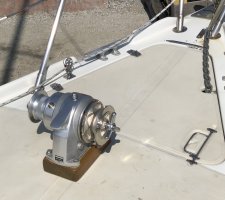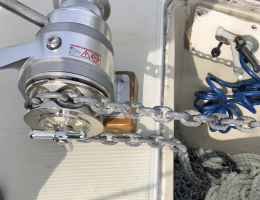Christian, I'm not expecting to be as fast as an electric windlass. My testing "on the hard" showed about 10" to 12" of chain with each bow-to-stern movement of the lever. But for me I think that's OK because the use of an electric windlass always sort made me nervous even though I never used one before. Things seem to go so fast and, to me, things looked like they could get out of control in a hurry. When I raised then chain on my manual windlass and got to the point where the anchor was swinging right off the bow, getting it up into the roller with a few short, controlled pulls on the lever went very easily. Maybe I'm just a paranoid sailor.

I can see a problem with being in a tight anchorage and a strong wind blowing where the boat could drift into another boat or a lee shore or shallow water.
There are many reasons that I went with a manual windlass, which I'll cover in the blog, but one of the best ones was that I noticed that a fair number of ocean cruising sailors use manual windlasses? Why? I suspect reliability is one of the reasons. A sailor I follow regularly on YouTube (Beside...ahem...Christian Williams, of course) is Kevin Boothby of
How To Sail Oceans. He's probably one of the most accomplished sailors I've seen mostly because his boat has no auxiliary engine, aside from a small outboard that he sometimes uses to move short distances in a harbor. Before using the outboard he was using a sculling oar. He has a manual windlass on his boat and so I had a few email chats with him on the subject. Those conversations finalized my decision to got "manual".
I had to also purchase a new anchor rode with my windlass because the chain on the old rode wouldn't work with it. So I now have 45 feet of chain and then the rest is a rope road. This should be more than enough for the Chesapeake Bay, and according to Captian Boothby, I should find myself pulling most of the rope in by hand till I got to the chain and then use the manual windlass for the rest, which is what he does. I can eve use the capstan to haul the rope in too if the wind is up. Or, as I've done in the past when the wind was strong on the nose, motor around and up to where the anchor is laid and then while drifting back haul in the rode because it'll be slacked off. I did that before when sailing solo and the wind was blowing about 20 knots or more.
So, I'm fairly optimistic about a manual windlass working out for me and my 70 year old bones. Of course, nothing beats a real world experience which I intend to document with a video once I can get the boat back in the water and head out to an anchorage.


